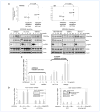Activation of FOXO3a is sufficient to reverse mitogen-activated protein/extracellular signal-regulated kinase kinase inhibitor chemoresistance in human cancer
- PMID: 20484037
- PMCID: PMC2895805
- DOI: 10.1158/0008-5472.CAN-09-4524
Activation of FOXO3a is sufficient to reverse mitogen-activated protein/extracellular signal-regulated kinase kinase inhibitor chemoresistance in human cancer
Abstract
Drug resistance is a central challenge of cancer therapy that ultimately leads to treatment failure. In this study, we characterized a mechanism of drug resistance that arises to AZD6244, an established mitogen-activated protein/extracellular signal-regulated kinase kinase (MEK) 1/2 inhibitor currently being evaluated in cancer clinical trials. AZD6244 enhanced the expression of transcription factor FOXO3a, which suppressed cancer cell proliferation. In AZD6244-resistant cancer cells, we observed the impaired nuclear localization of FOXO3a, reduced FOXO3a-mediated transcriptional activity, and decreased the expression of FOXO3a target gene Bim after cell treatment with AZD6244. Resistant cells could be sensitized by phosphoinositide 3-kinase (PI3K)/AKT inhibitors, which are known to enhance FOXO3a nuclear translocation. Our findings define FOXO3a as candidate marker to predict the clinical efficacy of AZD6244. Furthermore, they suggest a mechanism of resistance to MEK inhibitors that may arise in the clinic yet can be overcome by cotreatment with PI3K/AKT inhibitors.
Copyright 2010 AACR.
Conflict of interest statement
No potential conflicts of interest were disclosed.
Figures





References
-
- Hanahan D, Weinberg RA. The hallmarks of cancer. Cell. 2000;100:57–70. - PubMed
-
- Vogelstein B, Kinzler KW. Cancer genes and the pathways they control. Nat Med. 2004;10:789–99. - PubMed
-
- Thompson N, Lyons J. Recent progress in targeting the Raf/MEK/ERK pathway with inhibitors in cancer drug discovery. Curr Opin Pharmacol. 2005;5:350–6. - PubMed
-
- Scholl FA, Dumesic PA, Khavari PA. Effects of active MEK1 expression in vivo. Cancer Lett. 2005;230:1–5. - PubMed
-
- Weinberg RA. ras Oncogenes and the molecular mechanisms of carcinogenesis. Blood. 1984;64:1143–5. - PubMed
Publication types
MeSH terms
Substances
Grants and funding
LinkOut - more resources
Full Text Sources
Other Literature Sources
Research Materials
Miscellaneous

